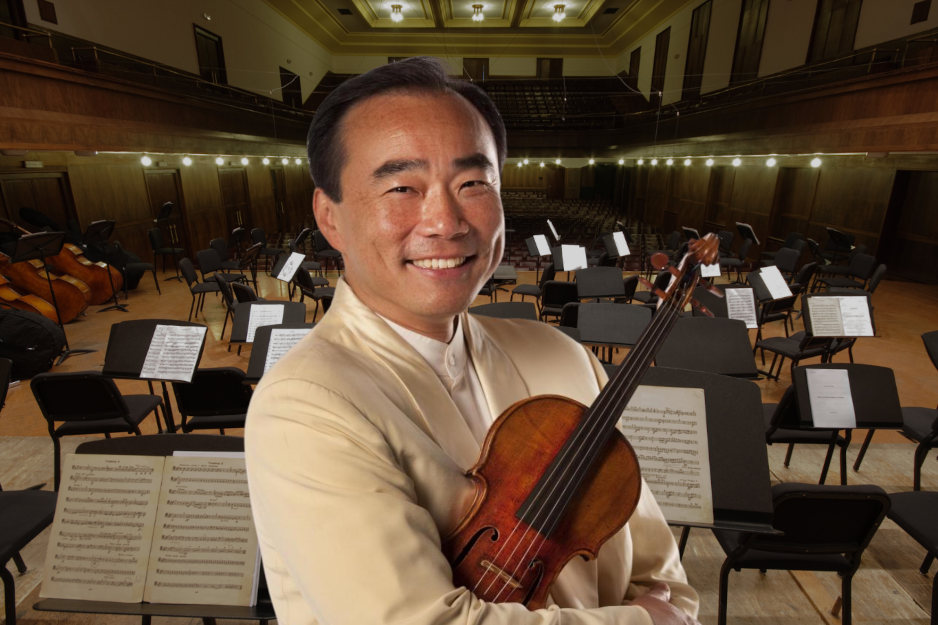Unlock the Secret Method Cho-Liang Lin Uses to Transform Beginners into Virtuosos—In Just 48 Hours!
Ever wondered how a world-class violinist like Cho-Liang Lin manages to master pieces so complex in just a matter of days—sometimes mere hours—when most musicians spend weeks or months grinding away? It’s not magic or some hidden talent alone; it’s about transforming your brain into what Lin calls a “faster thinking machine.” In today’s lightning-paced music industry, where last-minute gigs and tight rehearsal schedules are the norm, his approach is a game-changer, teaching students to cut through the noise, zero in on what truly matters, and perform with emotional punch—even if technical perfection takes a back seat. If you’ve ever thought mastering a tough piece quickly was impossible, think again. This method doesn’t just teach fast learning—it builds lasting skills that keep musicians sharp and adaptable for a lifetime. Ready to dive into the secrets behind Lin’s accelerated learning techniques and why they’re rewriting the rules of music education? LEARN MORE

Key Takeaways
- Professional musicians often face 48–72 hour deadlines to learn complex repertoire—something most conservatory training doesn’t prepare students for.
- Violinist Cho-Liang Lin teaches accelerated learning techniques drawn from decades of high-level performance.
- Core principles include active recall, focused “surgical” practice, pattern recognition, and cognitive load management.
- Students rehearse in real-world, time-constrained scenarios to develop professional readiness.
- Method prioritizes musical communication and emotional connection when technical perfection isn’t possible under tight deadlines.
- Skills gained—diagnostic listening, leadership flexibility, interpretive adaptability—are crucial for lasting careers in music.
When the Philadelphia Orchestra calls with a last-minute substitution request, there’s no time for a leisurely learning process. Professional musicians routinely face 48 to 72-hour deadlines to master challenging repertoire, a reality most conservatory students never encounter during their academic training.
The pressure intensifies at major summer venues. Tanglewood and the Hollywood Bowl present three different orchestral programs per week, with top orchestras assembling each concert in just one or two rehearsals. Musicians must arrive having already mastered their parts individually.
This disconnect between academic preparation and professional demands has led some pedagogues to develop new teaching methods. Violinist Cho-Liang Lin, who teaches at the Juilliard School and Rice University, has developed an approach based on his four decades of performing with orchestras, including the Boston Symphony, Cleveland Orchestra, and Royal Concertgebouw Orchestra. His extensive recording career spans from core classical repertoire to contemporary premieres, providing him with insights into rapid musical adaptation.
“Students usually have more time to figure things out, because they have a whole school year—30 weeks—to digest a work,” Lin states. “But in a professional setting, you don’t have 30 weeks. Sometimes you only have three days.” This reality shapes both his teaching philosophy and performance schedule, as he continues to balance academic responsibilities with professional engagements.
The Accelerated Learning Framework
The approach centers on developing what Lin terms a “faster thinking machine.” This methodology transforms how musicians process and internalize new material, departing from conservatory norms where students perfect single works over entire semesters.
A recent summer festival provided the ultimate test. “I recently played with my students in a summer festival where they were given exactly two hours to put a piece together,” Lin explains. “That was very much a real-world professional process.” This mirrors the demanding schedules of his upcoming festival appearances, where rapid preparation remains essential.
The technique incorporates several core principles:
- Active recall application: Self-testing methods proven to enhance retention rates by up to 50% according to educational psychology research
- Surgical practice allocation: Focusing 80% of available time on the 20% of material that presents the most significant technical challenges
- Professional pattern recognition: Teaching students to distinguish sight-readable passages from those requiring intensive woodshedding
- Cognitive load management: Breaking complex work into manageable segments processed in rapid succession
Professional musicians validate this approach. Part of the skill of working as a musician is being able to look at a part and laser out the bar or two that needs a bit of work while leaving the sight-readable portions to the rehearsal room. Lin’s students master this discrimination through repeated exposure to time-constrained scenarios.
His students also learn specific practice techniques. Lin recommends Bach fugues for building both technical facility and mental stamina. He shares his regimen of slow, focused play-throughs for maintaining accuracy under pressure, methods he has refined throughout Cho-Liang Lin’s distinguished career.
Professional Rehearsal Integration
Lin places students directly into authentic performance scenarios, rather than relying on classroom simulations. This immersion offers immediate feedback, which is unavailable in traditional pedagogical settings.
“When I’m playing with them, I can show exactly what I mean,” Lin notes. “I have to practice what I preach, as the expression goes.”
Live demonstrations prove particularly effective. Lin describes his real-time coaching: ‘I’ll tell them, “Watch this—don’t come in too loud here.” Listen! Someone else is playing the main tune. You’re only supporting.”
Chamber music pedagogy emphasizes that there is perhaps nothing more necessary and basic in learning chamber music than arriving at your first rehearsal prepared. Lin compresses this preparation timeline from weeks to hours while maintaining professional standards. His extensive experience with ensembles like the Hong Kong Philharmonic informs these high-pressure preparation techniques.
His summer festival experience exemplifies this compression. Students received chamber works with minimal notice, forcing them to make rapid decisions about fingerings, bowings, and interpretive choices typically refined over multiple rehearsals.
The payoff comes when students face real-world scenarios. Concerts and opportunities come in at the last minute, sometimes leaving us barely enough time to practice the music before being thrust out onto a stage. Lin’s students navigate these situations with confidence gained through training.
Prioritizing Musical Communication
The methodology redefines the relationship between preparation time and performance quality. A pivotal teaching moment occurred when Lin returned to a significant work after a four-decade hiatus.
“I recently picked up a piece, a very substantial work that I had not played in 41 years,” he recounts. “And even 41 years ago, I did not exactly learn it particularly well.”
Technical limitations notwithstanding, audience response surprised him. “What surprised me was that the audience loved it because they felt the impact of the music,” Lin observes. This philosophy of emotional connection over technical perfection extends beyond the concert hall, as evidenced by his contributions to film soundtracks, where musical communication serves dramatic narrative.
This revelation reshaped the teaching approach. Despite his admission that “If it’s not all perfectly placed, I feel like the performance is a failure,” the experience demonstrated how students could prioritize emotional authenticity when time constraints prevent exhaustive technical preparation.
Performance psychology research confirms this approach. Studies indicate that audiences respond more strongly to musical conviction than to technical precision, particularly in live performance contexts, where energy and communication create memorable experiences.
Lin’s students learn this hierarchy through practical application. When facing a two-hour preparation window, they must decide whether to drill a difficult passage repeatedly or ensure they understand the work’s emotional arc. Lin guides them toward choices that serve the music’s communicative purpose.
Long-Term Professional Development
The rapid-learning methodology develops skills extending throughout musicians’ careers. Students acquire the tools for navigating an industry where flexibility is key to success.
Research on professional chamber ensembles reveals specific competencies distinguishing successful groups. This pedagogical approach cultivates these abilities during formative training years:
- Diagnostic listening: Identifying ensemble problems within seconds and proposing solutions
- Dynamic leadership: Shifting between leading and supporting roles based on musical demands
- Interpretive flexibility: Adapting personal musical choices to ensemble consensus rapidly
- Technical triage: Determining which passages require individual practice versus group rehearsal
- Performance psychology: Maintaining composure when preparation falls short of ideal
Former students report that these skills prove invaluable. One Rice graduate, now performing with major orchestras, credits Lin’s rapid-learning exercises for her ability to confidently accept last-minute engagements, similar to those featured in prestigious concert series.
Lin acknowledges modern constraints facing musicians. Arts education budgets shrink while students juggle multiple commitments, making efficiency essential. His methods maximize limited resources without sacrificing artistic integrity.
The approach also addresses career longevity. Musicians maintaining active performing careers must constantly learn new repertoire. Lin’s techniques ensure they can do so efficiently throughout their professional lives.
Implications for Music Education
The rapid-learning methodology addresses a critical gap in conservatory training. While most programs excel at developing technical proficiency over extended periods, few prepare students for the time constraints typical in professional engagements. “The question is how to turn your mind into a faster thinking machine that gets you up to performance level very quickly,” Lin notes. “It’s not a leisurely process.”
Implementation of these techniques requires institutional adaptation. Music schools could introduce mock audition weeks, surprise performance assignments, or compressed rehearsal periods that mirror professional scenarios. Faculty development programs would need to include training in accelerated coaching methods, moving beyond traditional semester-long progression models.
The broader implications extend throughout the classical music industry. Orchestras operating under financial constraints benefit from musicians who can prepare repertoire quickly and efficiently. Chamber ensembles can accept more engagements when members possess rapid-learning skills. These competencies have shifted from advantageous to essential, with students who master accelerated preparation techniques entering the profession better equipped for its current demands.
FAQ
What is Cho-Liang Lin’s accelerated learning method?
It’s a training approach that teaches musicians to master new works in days rather than weeks, focusing on efficiency, selective practice, and real-world rehearsal scenarios.
Why is this training important for musicians?
Professional engagements often require rapid repertoire preparation. Lin’s method equips students to meet these demands without sacrificing performance quality.
How does the method work in practice?
Students use active recall, allocate most practice time to the toughest passages, identify easy vs. difficult sections, and break music into manageable segments.
Does this approach sacrifice technical precision?
While not every note can be perfected under extreme time constraints, the method emphasizes emotional authenticity and musical communication, which audiences value highly.
Who benefits most from this training?
Aspiring and professional musicians who face tight preparation timelines—especially those in orchestras, chamber ensembles, or festival settings.



















Post Comment